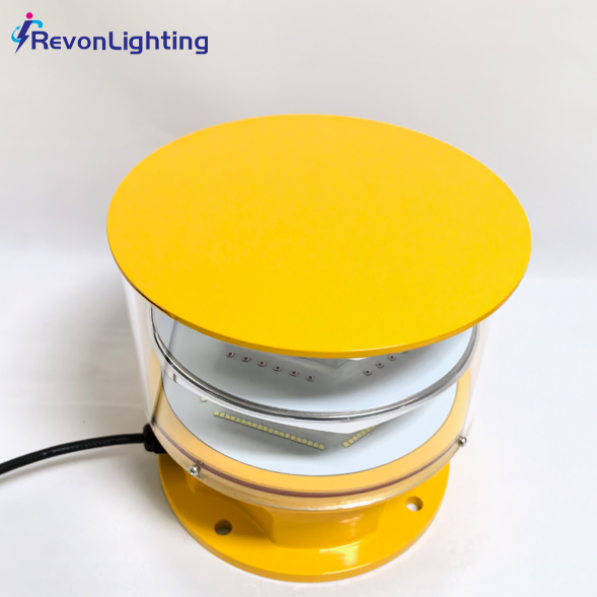Aviation safety is an intricate domain that encompasses numerous systems and technologies designed to ensure the smooth operation of flights and the prevention of accidents. One of the critical components in this safety matrix is airplane warning lights. These lights are essential for marking obstacles and providing visual signals that aid pilots during various phases of flight. This article explores the significance, types, and technological advancements of airplane warning light, underscoring their vital role in maintaining aviation safety.
The Significance of Airplane Warning Lights
Airplane warning lights are specialized lighting systems installed on various structures, such as communication towers, wind turbines, tall buildings, and cranes. Their primary function is to make these obstacles visible to pilots, particularly during night-time operations and in low-visibility conditions. This visibility is crucial for preventing collisions and ensuring the safe navigation of aircraft.
Enhancing Night-Time Visibility:
Airplane warning lights ensure that tall structures are visible to pilots during night-time operations. This is particularly important for structures that may not be easily noticeable in the dark.
Improving Safety in Adverse Weather Conditions:
During poor weather conditions such as fog, rain, or snow, airplane warning lights provide critical visual cues to pilots, helping them to navigate safely and avoid potential obstacles.

Regulatory Compliance:
Aviation authorities such as the Federal Aviation Administration (FAA) and the International Civil Aviation Organization (ICAO) mandate the use of airplane warning lights on structures exceeding specific heights. Compliance with these regulations is essential for maintaining aviation safety and avoiding legal liabilities.
Types of Airplane Warning Lights
Airplane warning lights can be classified into several types based on their intensity and color, each serving specific purposes:
Low-Intensity Lights:
Typically red, low-intensity lights are used for marking structures of relatively low height. They are visible at night and are designed to provide sufficient warning to pilots flying at lower altitudes.
Medium-Intensity Lights:
Medium-intensity lights can be either red or white. They are used for marking taller structures and are visible during both day and night. These lights often flash to attract attention and provide a clear warning of the obstacle’s presence.
High-Intensity Lights:
High-intensity lights are usually white and extremely bright, making them visible from great distances. They are used for very tall structures, such as broadcast towers and tall buildings, ensuring these obstacles are seen in all weather conditions and from afar.
Technological Advancements in Airplane Warning Lights
The field of airplane warning lights has seen significant technological advancements, particularly with the introduction of LED technology and smart lighting solutions. These advancements have enhanced the efficiency, reliability, and sustainability of warning light systems.
LED Technology:
The adoption of LED (Light Emitting Diode) technology has revolutionized airplane warning lights. LEDs consume significantly less energy than traditional incandescent bulbs, resulting in substantial energy savings and lower operational costs. They also have a much longer lifespan, reducing the need for frequent replacements and maintenance. Additionally, LEDs provide bright, consistent illumination, which is crucial for ensuring the visibility of obstacles.
Remote Monitoring and Control:
Modern airplane warning lights can be equipped with remote monitoring and control capabilities. These systems allow for real-time monitoring of the lights’ operational status and can alert maintenance personnel to any issues. This ensures continuous compliance with safety regulations and minimizes downtime.
Smart Lighting Solutions:
Smart lighting systems can adjust the intensity of the lights based on ambient light conditions, optimizing energy usage and enhancing visibility. For example, lights can be dimmed during daylight hours and brightened at night or during foggy conditions.
| airplane warning lights | 12 |
| 23 | 34 |
Solar Power Integration:
Solar-powered airplane warning lights are becoming increasingly popular, particularly in remote areas. These lights are equipped with solar panels and batteries, providing a sustainable and cost-effective solution for marking obstacles. Solar power reduces reliance on the electrical grid, making these lights suitable for a wide range of applications.
Conclusion
Airplane warning lights are indispensable components of aviation safety infrastructure. They ensure that tall structures are visible to pilots, reducing the risk of collisions and enhancing safe navigation. Compliance with regulatory standards set by aviation authorities like the FAA and ICAO is crucial for maintaining safety and avoiding legal liabilities.
Technological advancements, such as LED lighting, remote monitoring, smart lighting solutions, and solar power integration, have significantly improved the efficiency, reliability, and sustainability of airplane warning lights. While the initial investment in high-quality warning lights may be significant, the long-term benefits in terms of safety, reduced maintenance costs, and regulatory compliance make it a worthwhile expenditure.
As aviation traffic continues to grow and technological innovations advance, the role of airplane warning lights will remain critical in ensuring the safety and efficiency of our aviation system. Investing in advanced, compliant warning light systems is not just a regulatory requirement but a commitment to safeguarding lives and enhancing the overall safety of aviation operations.